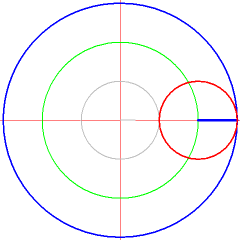Complex Analysis/Curves
Introduction
In the Mathematics a curve (of lat. curvus for "bent", "curved") is a one dimensionals object in a two-dimensional plane (i.e. a curve in the plane) or in a higher-dimensional space.
Parameter representations
- Multidimensional analysis: A continuous mapping is a curve in the .
- Complex Analysis: Continuous mapping is a path in (see also path for integration).
Explanatory notes
A curve/a way is a mapping. It is necessary to distinguish the track of the path or the image of a path from the mapping graph. A path is a steady mapping of a interval in the space considered (e.g. or ).
Example 1 - Plot

Example 1 Curve as a solution of an algebraic equation
|
|
resp. . Determine for the curve all with |
Examples 2
The mapping
describes the Unit circle in the plane .
describes the Unit circle in the Gaussian number level .
Examples 3
The mapping
describes a curve with a simple double point at , corresponding to the parameter values and .
Direction
As a result of the parameter representation, the curve receives a directional direction in the direction of increasing parameter.[1][2]
Curve as Image of Path
Let or be a path. is the image of a path
- .
Difference - Graph und Curve
For a curve the Supr or curve is a subset of , while the graph of function is.
Task - Plot Graph und Curve
use CAS4Wiki :
Animation of the track

Curves in Geogebra
First create a slider for the variable and two points or and generate with the sum of both location vectors of and . Analyze the parameterization of the curves.
Geogebra - Interactive Implementation
Create a value slider in Geogebra with the variable name and create the following 3 points step by step in the command line of Geogebra and move the value slider for after that.
K_1:(2*cos(t),2 * sin(t))
K_2:(cos(3*t),sin(3*t))
K: K_1+K_2
The construction about will create an interactive representation of the the follow path . Observe the point in Geogebra.
See also interaktive Example in Geogebra
Representations of Image Sets by Equations
A curve can also be described by one or more equations in the coordinates. The solution of the equations represents the curve:
- The equation describes the unit circle in the plane.
- The equation describes the curve indicated above in parameter representation with double point.
If the equation is given by a Polynomial, the curve is called algebraic.
Graph of a function
Functiongraphs are a special case of the two forms indicated above: The graph of a function
can be either as a parameter representation or as equation , wherein the solution quantity of the equation represents the curve by . If theMathematics education of Curve sketching is spoken, this special case is usually only said.
Closed curves
Closed curves are continuous mappings with . In the function theory, we need curves in , which can be continuously differentiated. These are called integration paths.
Number of circulations in the complex numbers
Smooth closed curves can be assigned a further number, thenumber of revolutions, which curve is parameterized according to the arc curve by
is given. The circulation theorem analogously to a curve in , states that a simple closed curve has the number of revolutions or .
Curves as Independent Objects
Curves without an ambient space are relatively uninteresting in w:en:Differential Geometry because every one-dimensional manifold is diffeomorphic to the real line or to the unit circle . Also, properties like the curvature of a curve are intrinsically undetectable.
In algebraic geometry and, correspondingly, in complex analysis, "curves" typically refer to one-dimensional complex manifolds, often also called Riemann surfaces. These curves are independent objects of study, with the most prominent example being elliptic curves. See curve (algebraic geometry)
Historical
The first book of Elements by Euclid began with the definition:
- "A point is that which has no parts. A curve is a length without breadth."
This definition can no longer be upheld today because, for example, there are Peano curves, i.e., continuous surjective mappings that fill the entire plane . On the other hand, the Sard's Lemma implies that every differentiable curve has zero area, i.e., as Euclid demanded, it truly has no breadth.
Interactive Representations of Curves in GeoGebra
- Tangent vector of a curve in for a curve with tangent vector
- Rolling curves Bicycle reflectors as an example of curves - Cycloid
See also
- Space curves in
Literature
- Ethan D. Bloch: A First Course in Geometric Topology and Differential Geometry. Birkhäuser, Boston 1997.
- Wilhelm Klingenberg: A Course in Differential Geometry. Springer, New York 1978.
References
- ↑ H. Neunzert, W.G. Eschmann, A. Blickensdörfer-Ehlers, K. Schelkes: Analysis 2: Mit einer Einführung in die Vektor- und Matrizenrechnung. Ein Lehr- und Arbeitsbuch. 2. Auflage. Springer, 2013, lSBN 978-3-642-97840-1, 23.5
- ↑ H. Wörle, H.-J. Rumpf, J. Erven: Taschenbuch der Mathematics. 12. Auflage. Walter de Gruyter, 1994, lSBN 978-3-486-78544-9
External Links
| Look up Kurve in Wiktionary, the free dictionary. |
Page Information
You can display this page as Wiki2Reveal slides
Wiki2Reveal
TheWiki2Reveal slides were created for the Complex Analysis' and the Link for the Wiki2Reveal Slides was created with the link generator.
- This page is designed as a PanDocElectron-SLIDE document type.
Translation and Version Control
This page was translated based on the following [https://de.wikiversity.org/wiki/Kurs:Funktionentheorie/Kurven Wikiversity source page] and uses the concept of Translation and Version Control for a transparent language fork in a Wikiversity:
- Source: Kurs:Funktionentheorie/Kurven - URL:
https://de.wikiversity.org/wiki/Kurs:Funktionentheorie/Kurven
- Date: 12/17/2024